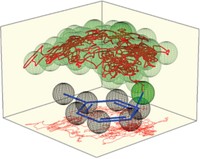Advertisement
Grab your lab coat. Let's get started
Welcome!
Welcome!
Create an account below to get 6 C&EN articles per month, receive newsletters and more - all free.
It seems this is your first time logging in online. Please enter the following information to continue.
As an ACS member you automatically get access to this site. All we need is few more details to create your reading experience.
Not you? Sign in with a different account.
Not you? Sign in with a different account.
ERROR 1
ERROR 1
ERROR 2
ERROR 2
ERROR 2
ERROR 2
ERROR 2
Password and Confirm password must match.
If you have an ACS member number, please enter it here so we can link this account to your membership. (optional)
ERROR 2
ACS values your privacy. By submitting your information, you are gaining access to C&EN and subscribing to our weekly newsletter. We use the information you provide to make your reading experience better, and we will never sell your data to third party members.
"Brute Force Breaks Bonds" reports that "Jeffrey S. Moore, Charles R. Hickenroth, and colleagues at the University of Illinois, Urbana-Champaign, have used mechanical energy to trigger ring openings and, in the process, steer the reactions away from products predicted by orbital symmetry rules" (C&EN, March 26, page 9). The experiments described were both creative and challenging, and they may portend useful applications, but there is a far simpler explanation for what Moore and coworkers observed.
In a solution, sonication (ultrasound) creates local regions of intense heating for brief periods of time during which temperatures often reach or exceed 1,000 °C. Molecules exposed to such high temperatures undergo extreme distortions due to high levels of vibrational excitation, rendering inapplicable the orbital symmetry rules that would apply to, for example, a benzocyclobutene molecule in a symmetrical, planar configuration. Highly distorted or diradical transition structures formed from substituted benzocyclobutenes would relax to products by paths that are governed by trajectories over energy surfaces impacted by steric constraints and dynamic effects; the overall reaction stereochemistry would not necessarily adhere strictly to the dictates of orbital symmetry theory.
We have studied the extent of stereochemical conservation in retro-Diels-Alder reactions of molecules (gas phase) heated to temperatures above 1,000 K by shock waves in chemical shock tubes. Such experiments produce rapid heating of short duration similar to that achieved by ultrasound, but under more controlled, homogeneous conditions. For example, a deuterium-labeled cyclohexene limited by orbital symmetry conservation rules to form only cis-1,2-ethylene-d2 and 1,3-butadiene forms some trans-1,2-ethylene-d2 as well, in percentages that rise rapidly as temperatures exceed 1,000 K (J. Am. Chem. Soc. 1993, 115, 11728). There are many similar published reports of reactions that become less and less inclined to follow the stereochemical predictions of orbital symmetry rules as temperatures are raised, and many other well-documented reactions of molecules with appropriate steric constraints that give orbital symmetry "forbidden" thermal reaction products without difficulty.
Thus, while the idea of mechanical-force-directed chemistry is intriguing, we are far from convinced that what Moore and his colleagues have reported is anything other than the expected result of thermal excitation to very high temperatures. The authors' claim that they pulled open a cyclobutene ring by tugging on its attached polymer arms seems, well, a bit of a stretch.
David K. Lewis
New London, Conn.
John E. Baldwin
Syracuse, N.Y.



Join the conversation
Contact the reporter
Submit a Letter to the Editor for publication
Engage with us on Twitter